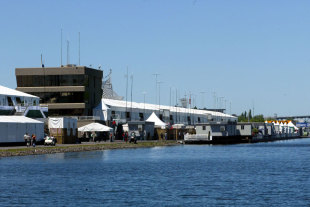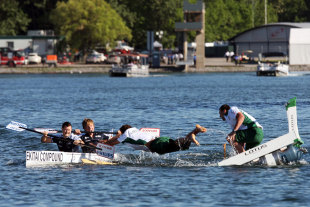
- Race:
- Canadian Grand Prix
If you fancy going to work by boat, Montreal is the place for you. As F1 paddocks go, this has always been considered one of the best, not through deliberate design but because of circumstance forced upon the Canadian organisers by the limited space available.
The track is on the perimeter road of a man-made island in the St Lawrence River; a more beautiful and different location for a grand prix being difficult to find. Built originally to house Expo 67, the island was also used for the 1976 Olympics thanks to the creation of a rowing lake down its middle. This massive stretch of water fringes the back of the paddock and affords a spectacular entry as you ply your way through water dappled by early morning sunshine.
Most F1 personnel travel by car, entry to the paddock being gained on foot via a temporary pontoon crossing the lake, a wobbly means of access that can indicate publically your stability after the night before. But it beats walking in from your average Tarmac car park.
The novelty value of Montreal's race track location triggered the inventive minds of teams a few years after the first Grand Prix in 1978. In those days, the race was held in late September/early October, an uncomfortable time of year when cold wind whipping off the St Lawrence would chill you to the bone.
But all that changed in 1982 when the date was shifted to June. Suddenly the rowing lake, which previously had been a forbidding shade of grey, became Sapphire blue and almost looked inviting.
There was talk of swimming its 300-metre breadth but, this being motor sport, someone, probably the worse for drink, came up with a plan to build a boat and attempt to cross the lake. The Leyton House team took up the challenge and, before they knew it, they had a race on their hands.
The rules were as uncomplicated as the methods of construction. The 'boats' had to be made from materials found in the paddock; purpose-made marine items were strictly forbidden. Given that this was a so-called 'flyaway race', packing cases and boxes were in plentiful supply. It was not the work of a moment for ingenious minds to come up with intriguing answers to the question of how to cross water as quickly as possible. Staying dry, however, would be another challenge, thanks mainly to the mischievous nature of spectators lining the edge as the race became a popular annual event on the Thursday afternoon.
The Jordan team mastered the art better than most to win more than once, lessons from the previous race carried forward successfully to the next.

By 1993, plywood from a packing case had been shaped into the form of an impressive two-seater canoe. Foam, normally used for the seat of a racing car, was moulded to make two floats, suspended on outriggers. The paddles were fashioned from wood and ply found in the garage. This had become a serious effort - mainly because Eddie Jordan had nothing to do with it, other than spot a photo opportunity and have 'his' boat painted in team colours with sponsors' logos permanently displayed.
Not so the Jordan B Team. In true spirit of the occasion, a second 'vessel' was made from plastic bins normally used to carry spare parts, these lashed to oil drums to provide buoyancy for what one team member, in a moment of rash enthusiasm, referred to as a boat.
The three-man crew, brave souls all, appeared wearing Viking gear, topped off with helmets and beards made from foam rubber. They were at a disadvantage from the start because one crew member would work his passage, not by rowing, but by beating a makeshift drum and waving an axe. If the intention was to scare the opposition witless then, judging by the gales of laughter, they failed gloriously.
On the signal to start, the Viking marauders splashed fully 10 yards before sinking with great dignity in the face of outrageous remarks from the shore.
Meanwhile, the A Team duo was paddling furiously to the opposite side where, the rules dictated, a change of crew should take place. It was at this point that someone noted the B team had been pushing the bounds of optimism somewhat but dispatching three Vikings to the far side in the hope that their warship would make it that far.
The A Team changed over with the slickness of a pit stop and went on to win handsomely by surviving abuse, fruit, flour and eggs hurled in a good humoured attempt to prevent the inevitable hat trick.
Sadly, the race was abandoned a few years later when some teams were thought to be taking this too seriously by bringing items that clearly had nothing to do with the running of two race cars (no surprise, really, given the boundless competitive nature of this business). In any case, the pressure of work and pre-race weekend preparation no longer allowed time for such frivolity.
Now, the only water-borne pleasure is travelling serenely along the lake on a shuttle boat; not as much fun but, as a means of arrival at work, one that takes some beating.
Maurice Hamilton writes for ESPN F1 in the build-up to each Grand Prix.
© ESPN Sports Media Ltd.
 Maurice Hamilton writes for ESPN F1. A veteran journalist in the paddock, Maurice Hamilton has been part of the Formula One scene since 1977 and was the Observer's motor racing correspondent for 20 years. He has written several books as well as commentating on Formula One for BBC Radio 5 Live
Maurice Hamilton writes for ESPN F1. A veteran journalist in the paddock, Maurice Hamilton has been part of the Formula One scene since 1977 and was the Observer's motor racing correspondent for 20 years. He has written several books as well as commentating on Formula One for BBC Radio 5 Live

